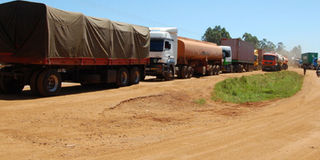URA’s disaster recovery system to curb data loss

Cargo trucks make their way into Uganda at the Busia border point. With the new Electronic Cargo Tracking System, cargo is tracked to avoid tax evasion. FILE PHOTO
What you need to know:
Revenue body has so far injected Shs41 billion into establishing the system.
Kampala- Uganda Revenue Authority (URA) is set to establish a disaster data recovery system this year as it automates its operations.
In an effort to improve revenue collections, URA has so far invested $14.3 million (about Shs41.3 billion) in the disaster recovery plan.
While meeting with officials from the British High Commission to Uganda and the Department for International Development (DFID) in Kampala on Wednesday, URA Commissioner Customs Richard Kamajugo said, currently, the authority is digitising operations to avoid data loss in case of a system breakdown.
“As the Authority automates (its operations), we should be available all the time and the system should provide alternative tracking sites in case of breakdown,” Mr Kamajugo said.
The Authority in May last year, launched Electronic Cargo Tracking System (ECTS) to enable traders and URA to track trucks after clearing at border points as a way of stopping tax evasion.
The ECTS depends on a control centre and automatic devices attached onto a cargo truck which repetitively give feedback to the team at the URA control centre on location of a vehicle, speed and status of the container.
According to Mr Kamajugo, the ECTS has helped traders recover up to Shs12 billion in incidences where thugs attacked the cargo trucks.
How the system works
The system alerts truck drivers and URA officials manning it in case of any attacks on the cargo in transit implying relevant security operatives can avert any damage or thefts of goods. $434,107 (about Shs1.2billion) has been saved by traders since URA adopted Electronic Cargo Tracking System (ECTS) in May last year.
Figures from URA indicate that transporters used to pay between $200 (about Shs580,000) and $250 (about Shs725,000) per day due to roadblocks by police and customs authorities across the region before the tax body partnered with TradeMark East Africa to have ECTS at cost of $2million (about Shs5.54 billion).
HOW SYSTEM HAS BEEN EFFECTIVE
According to URA, by March, 100 per cent of customs transactions will be carried out through the Automated System for Customs Data (ASYCUDA world). The system allows submission of customs declarations online rather than manual as it was in the past.
The ASYCUDA World (AW) has improved traders’ time to clear their goods in an average of one day compared to five days using the manual system, transparency of customs operations through status notifications throughout declaration processing.
AW has also facilitated regional revenue authorities interface further leading to faster regional integration.
To the business community, AW has helped traders access, submit and monitor the status of their customs declarations from anywhere.




